[ad_1]
general view of visitors are seen at Samsung booth during the chinajoy 2023 at Shanghai new expo center in Shanghai, China on July 28, 2023 (Photo by Ying Tang/NurPhoto via Getty Images)
Nurphoto | Nurphoto | Getty Images
South Korea’s Samsung Electronics reported Tuesday quarterly operating profit that was better than expected despite dropping 77.6% from a year ago.
While it was a decline year-on-year, third quarter operating profit jumped 262.6% from the second quarter, signaling that a memory chip glut may be bottoming out. First quarter operating profit plummeted 85.15% from the fourth quarter of 2022, while second-quarter operating profit saw only 4.68% improvement from the first quarter.
Here are Samsung’s third-quarter results versus estimates:
- Revenue: 67.4 trillion Korean won (about $50 billion), vs. 67.8 trillion Korean won expected by analysts polled by LSEG.
- Operating profit: 2.43 trillion Korean won, vs. 2.3 trillion Korean won expected by LSEG analysts.
Samsung’s revenue for the quarter ending September fell 12.2% from a year ago, while operating profit dropped 77.6% in the same period.
Earlier this month, Samsung estimated third-quarter revenue would be 67 trillion Korean won and operating profit to be 2.4 trillion won.
The South Korean chip giant is the largest dynamic random-access memory chip maker in the world. Its memory chips are found in consumer devices such as smartphones and computers.
“In the fourth quarter, uncertainties persist regarding the market’s recovery driven by wars and geopolitical risks, gradual demand rebound and ongoing customer inventory adjustments,” said Samsung during its earnings call on Tuesday.
“Nevertheless, we’re observing initial indications of demand, gradually stabilizing and improving, supported by recovering consumer sentiment, easing inflation and major customers introducing new products, particularly in the PC and mobile segments,” Samsung said.
On the outlook for memory demand, Samsung said it expects fourth quarter demand to pick up with year-end promotions, new product launches by its major customers as well as strong demand for generative AI.
Large language models such as ChatGPT require a lot of high-performance memory chips, which enable such generative AI models to remember details from past conversations and user preferences in order to generate humanlike responses.
In a press release ahead of its earnings call, Samsung said that it “received numerous purchase inquiries amid widening awareness of the industry reaching a bottom, following the industry-wide production cuts.” It added that it continued to expand sales of advanced-node products.
These advanced-node products include DDR5 — double data rate 5 synchronous dynamic random-access memory, and UFS4.0 — flash storage for the 5G era.
“Our view on a meaningful profit recovery for the next several quarters led by memory is intact, with the larger industry-wide production cuts, gradually improving demand trends, as well as mix improvement towards high-average selling price products such as DDR5,” said Goldman Sachs in an Oct. 12 report.
The investment firm maintained a “buy” rating with an unchanged target price of 93,000 won. Samsung shares were down 0.30% at 67,100 won on Tuesday morning.
Signs of recovery
Global smartphone sell-through volumes fell 8% year-on-year in the third quarter of 2023, the ninth consecutive quarter to record a decline, according to Counterpoint Research. This was largely because of the slower-than-expected recovery in consumer demand.
Smartphone and PC maker were grappling with excess inventories of memory chips after stockpiling to meet increased demand for consumer devices during the pandemic. Inflation has caused consumers to rein in spending and cut back on purchases of consumer devices, driving down demand and prices for memory chips.

But the market grew 2% quarter-over-quarter bolstered by a positive performance in September, signaling a market recovery ahead.
“We expect earnings to rebound from 4Q23, given further product mix improvement on expanding sales of high-bandwidth memory 3 and a memory price hike,” said SK Kim, analyst at Daiwa Capital Markets, in an Oct. 3 note.
“For memory, we assume a meaningful narrowing of losses due to a further product mix improvement and reversal of inventory write-down from the memory price recovery. For display, we expect a further earnings improvement on expanding supply of OLED panels for iPhone 15 models,” said Kim.
Continued 2024 momentum expected
Samsung said that it will be expanding its sales of advanced-node products to meet demand for high performance chips in generative AI.
“We will actively address demand for generative AI by increasing our HBM3 and HBM3E portion of sales on the back of the largest production capacity in the industry,” Samsung said Tuesday, referring to the next generation memory processors with high bandwidth memory.
Local media reported that Samsung is expected to supply high-performance DRAM chips and HBM3 to U.S.-based chip designer Nvidia. Nvidia’s shares have surged 187.54% year-to-date thanks to booming demand for its AI chips.
Kim of Daiwa Capital said they expect “growing opportunities related to AI demand in 2024” for Samsung.
“In addition to supplying HBM3 to Nvidia starting from 4Q23 and expanding supply in 2024, we expect that Samsung Electronics will supply HBM3P, targeting next-gen AI GPUs from mid-2024,” said Kim in an Oct. 3 note.
[ad_2]

